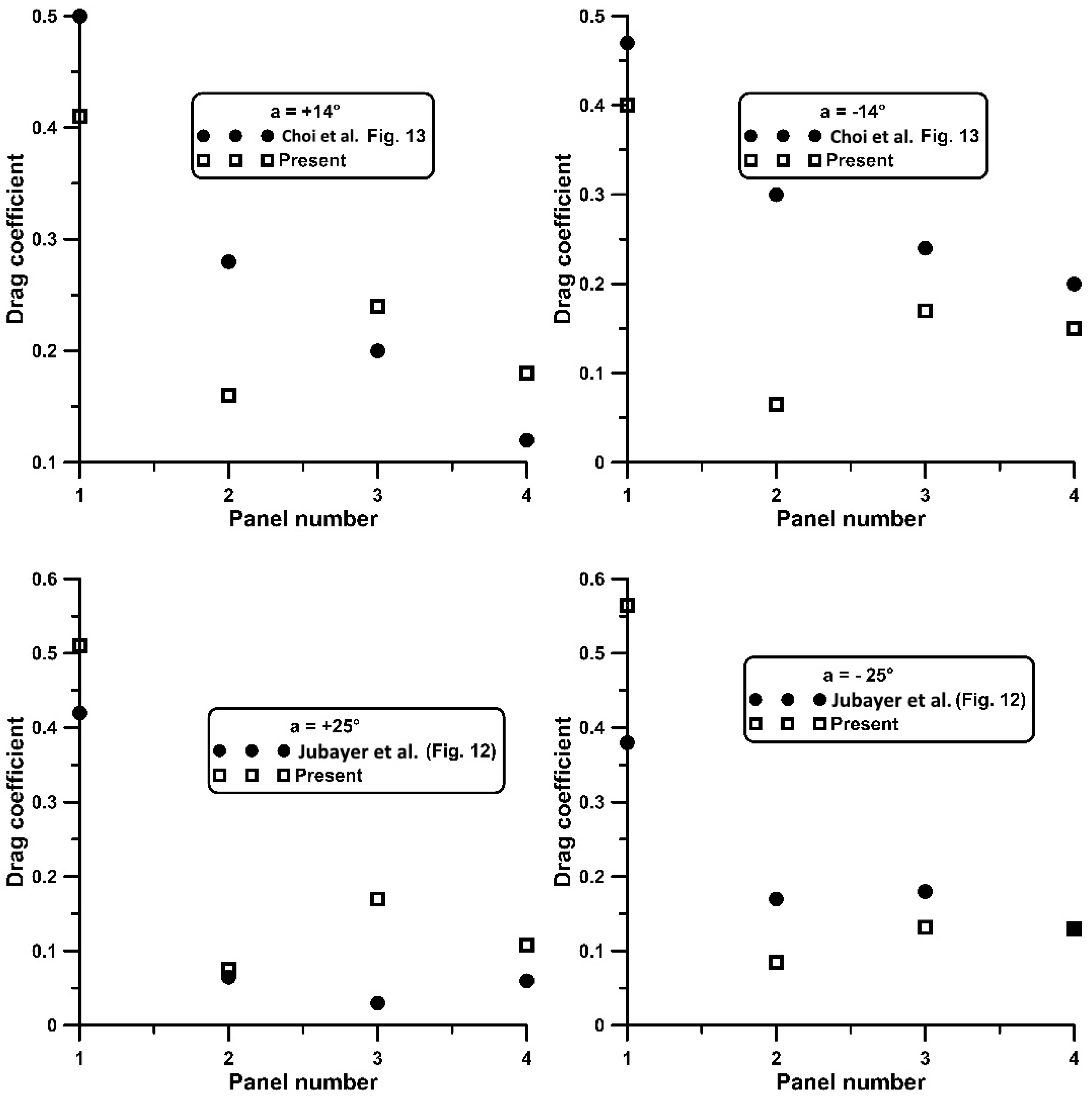Ground Clearance Effects on the Aerodynamic Loading of Tilted Flat Plates in Tandem
Abstract
1. Introduction
2. Models and Experimental Procedure
2.1. Four-Plate Set Up
2.1.1. Blockage Effect
2.1.2. Measurement Procedure
2.2. Six-Plate Set Up
3. Results
3.1. Isolated Tilted Panel
3.2. Four Plates in Tandem–Drag Measurements
3.3. Six Plates in Tandem–Pressure Measurements
4. Discussion
5. Limitations of Present Work
6. Conclusions
- -
- A local minimum of the curve slope appears for the 180° wind direction, between 40° and 60° tilt angles, for both the first plate as well as an isolated plate. As a result, the for the 180° wind direction is higher (up to 25%) compared to the 0° wind direction for tilt angles smaller than 40°.
- -
- Ground clearance increase is associated with an increase in , especially in the downstream located plates (from 2nd to 4th) by more than 40%, and up to 20% for the first plate, being more evident at positive tilt angles (0° wind direction).
- -
- The Cd distribution along the plate series starts with a maximum value on the first plate, at least twice as high as that of the subsequent plates, it drops on the second and it recovers in the rest of the plates.
- -
- Pressure distributions are relatively uniform on the pressure side, in contrast to the suction side, where pressure minima (high negative values) occur at the leading edge region, far from the mid-span. A practical implication of this, is the increased loading of the PV modules located at the edges (in the spanwise direction) of a PV array, either at the lower part (in case of a 0° wind direction) or its upper part (in case of a 180° direction).
- -
- With the exception of the pressure side of the first windward plate, the pressure coefficients are negative on all plates, exhibiting higher absolute values on their suction sides. Consequently, there is pressure recovery in the passage between neighbouring plates, being more pronounced between the first and the second. In the remaining plates, there is a tendency for the pressure spatial variations to be smoothed out streamwise.
Author Contributions
Funding
Data Availability Statement
Acknowledgments
Conflicts of Interest
References
- World Solar Investment Report 2023. Available online: https://isolaralliance.org/uploads/docs/1885d3247cb1a2c5c86d9bf1599a66.pdf (accessed on 10 April 2025).
- Aly, A.M.; Bitsuamlak, G. Aerodynamics of ground-mounted solar panels: Test model scale effects. J. Wind Eng. Ind. Aerodyn. 2013, 123, 250–260. [Google Scholar] [CrossRef]
- Aly, A.M. On the evaluation of wind loads on solar panels: The scale issue. Sol. Energy 2016, 135, 423–434. [Google Scholar] [CrossRef]
- Khaled, M.F.; Aly, A.M. Assessing aerodynamic loads on low rise buildings considering Reynolds number and turbulence effects: A review. Adv. Aerodyn. 2022, 4, 24. [Google Scholar] [CrossRef]
- Warsido, W.P.; Bitsuamlak, G.T.; Barata, J.; Chowdhury, A.G. Influence of spacing parameters on the wind loading of solar array. J. Fluids Struct. 2014, 48, 295–315. [Google Scholar] [CrossRef]
- Ginger, J.D.; Bodhinayake, G.G.; Ingham, S. Wind Loads on Ground Mounted Solar Panels; Technical Report; James Cook University: North Queensland, Australia, 2019; ISBN 978-0-9954471-9-6. [Google Scholar]
- Wittwer, A.R.; Podestá, J.M.; Castro, H.G.; Mroginski, J.L.; Marighetti, J.O.; De Bortoli, M.E.; Paz, R.R.; Mateo, F. Wind loading and its effects on photovoltaic modules: An experimental–Computational study to assess the stress on structures. Sol. Energy 2022, 240, 315–328. [Google Scholar] [CrossRef]
- Ortiz, X.; Rival, D.; Wood, D. Forces and moments on flat plates of small aspect ratio with application to PV wind loads and small wind turbine blades. Energies 2015, 8, 2438–2453. [Google Scholar] [CrossRef]
- Jubayer, C.M.; Hangan, H. A numerical approach to the investigation of wind loading on an array of ground mounted solar photovoltaic (PV) panels. J. Wind Eng. Ind. Aerodyn. 2016, 153, 60–70. [Google Scholar] [CrossRef]
- Shademan, M.; Naghib-Lahouti, A. Effects of aspect ratio and inclination angle on aerodynamic loads of a flat plate. Adv. Aerodyn. 2020, 2, 14. [Google Scholar] [CrossRef]
- Choi, S.M.; Lee, G.R.; Park, C.D.; Cho, S.H.; Lim, B.J. Wind load on the solar panel array of a floating photovoltaic system under extreme hurricane conditions. Sustain. Energy Technol. Assess. 2021, 48, 101616. [Google Scholar] [CrossRef]
- Ai, Y.; Zhou, L.; Tse, K.T.; Zhang, H. Interference and ground effects on flow past two inclined flat plates in tandem arrangement. Ocean. Eng. 2023, 270, 113653. [Google Scholar] [CrossRef]
- Bao, T.; Li, Z.; Pu, O.; Yang, Y.; Huang, B.; Wu, H. Field measurement-based research on wind pressure interference effects of tracking photovoltaic arrays. J. Wind Eng. Ind. Aerodyn. 2025, 257, 105971. [Google Scholar] [CrossRef]
- Pieris, S. Aerodynamics of Finite-Span Inclined Flat Plates in Ground Proximity. Ph.D. Thesis, University of Waterloo, Waterloo, ON, Canada, 2023. Available online: https://hdl.handle.net/10012/19853 (accessed on 8 March 2025).
- Rojewski, A.; Bartoszewicz, J. Numerical analysis of influence of the wing in ground effect on aircraft lift coefficient and on car downforce coefficient. J. Mech. Transp. Eng. 2017, 69, 47–54. [Google Scholar] [CrossRef]
- Lee, T.; Lu, A.; Tremblay-Dionne, V. Experimental study of aerodynamics and wingtip vortex of a rectangular wing in flat ground effect. ASME J. Fluids Eng. 2019, 14, 111108. [Google Scholar] [CrossRef]
- Taleghani, A.S.; Ghajar, A. Aerodynamic characteristics of a delta wing aircraft under ground effect. Front. Mech. Eng. 2024, 10, 1355711. [Google Scholar] [CrossRef]
- Lappalainen, K.; Valkealahti, S. Output power variation of different PV array configurations during irradiance transitions caused by moving clouds. Appl. Energy 2017, 190, 902–910. [Google Scholar] [CrossRef]
- Tieleman, H.W. Wind tunnel simulation of wind loading on low-rise structures: A review. J. Wind Eng. Ind. Aerodyn. 2003, 91, 1627–1649. [Google Scholar] [CrossRef]
- Larose, G.L.; D’Auteuil, A. On the Reynolds number sensitivity of the aerodynamics of bluff bodies with sharp edges. J. Wind Eng. Ind. Aerodyn. 2006, 94, 365–376. [Google Scholar] [CrossRef]
- Bailey, S.C.C.; Hultmark, M.; Monty, J.P.; Alfredsson, P.H.; Chong, M.S.; Duncan, R.D.; Vinuesa, R. Obtaining accurate mean velocity measurements in high Reynolds number turbulent boundary layers using Pitot tubes. J. Fluid Mech. 2013, 715, 642–670. [Google Scholar] [CrossRef]
- White, F.M. Fluid Mechanics. In Textbook, 4th ed.; McGraw-Hill: New York, NY, USA, 1999; ISBN 0071168486. [Google Scholar]
- Barlow, J.B.; Rae, W.H.; Pope, A. Low Speed Wind Tunnel Testing., 3rd ed.; John Wiley & Sons, Inc: New York, NY, USA, 1999; ISBN 978-0-471-55774-6. [Google Scholar]
- Maskell, E.C. A Theory of the Blockage Effects on Bluff Bodies and Stalled Wings; Reports and Memoranda No. 3400; Aeronautical Research Council: Ottawa, ON, Canada, 1963. [Google Scholar]
- Okamoto, M.; Azuma, A. Aerodynamic characteristics at low Reynolds numbers for wings of various planforms. AIAA J. 2011, 49, 1135–1150. [Google Scholar] [CrossRef]
- Miller, R.; Zimmerman, D. Wind Loads on Flat Plate Photovoltaic Array Fields. Phase II Final Report; U.S. Department of Energy: Seattle, WA, USA, 1979. [Google Scholar]
- Shademan, M.; Barron, R.M.; Balachandar, R.; Hangan, H. Numerical simulation of wind loading on ground-mounted solar panels at different flow configurations. Can. J. Civ. Eng. 2014, 41, 728–738. [Google Scholar] [CrossRef]
- Petrilli, J.; Paul, R.; Gopalarathnam, S.; Frin, N.T. A CFD Database for Airfoils and Wings at Post-Stall Angles of Attack. Presented at AIAA 2013–2916, Fluid Dynamics and Co-Located Conferences, San Diego, CA, USA, 24–27 June 2013. 31st AIAA Applied Aerodynamics Conference. [Google Scholar]
- Hoerner, S.F. Fluid Dynamic Drag; Catalog Card Number 64-19666; USA Library on Congress: Washington, DC, USA, 1965. [Google Scholar]

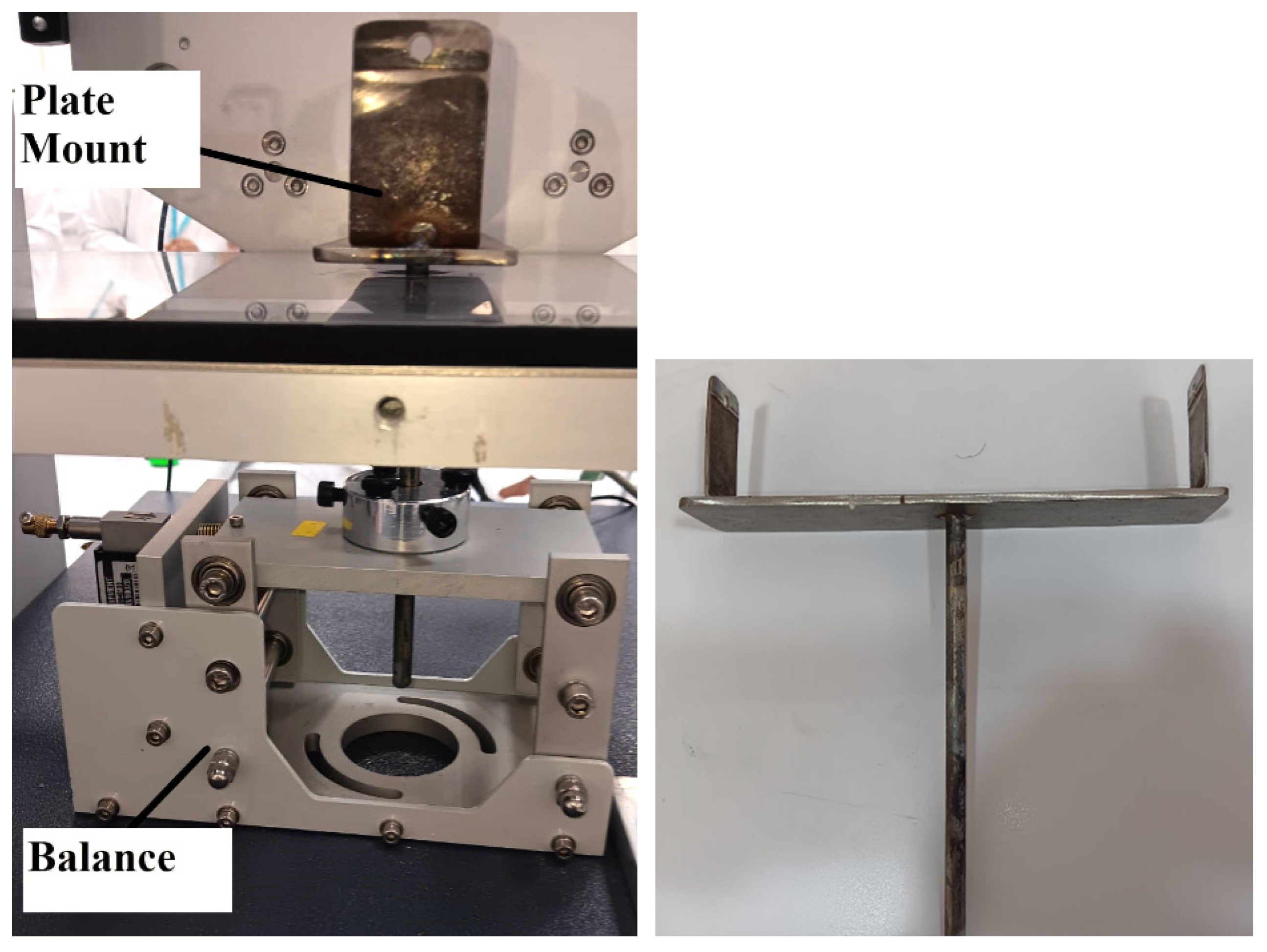
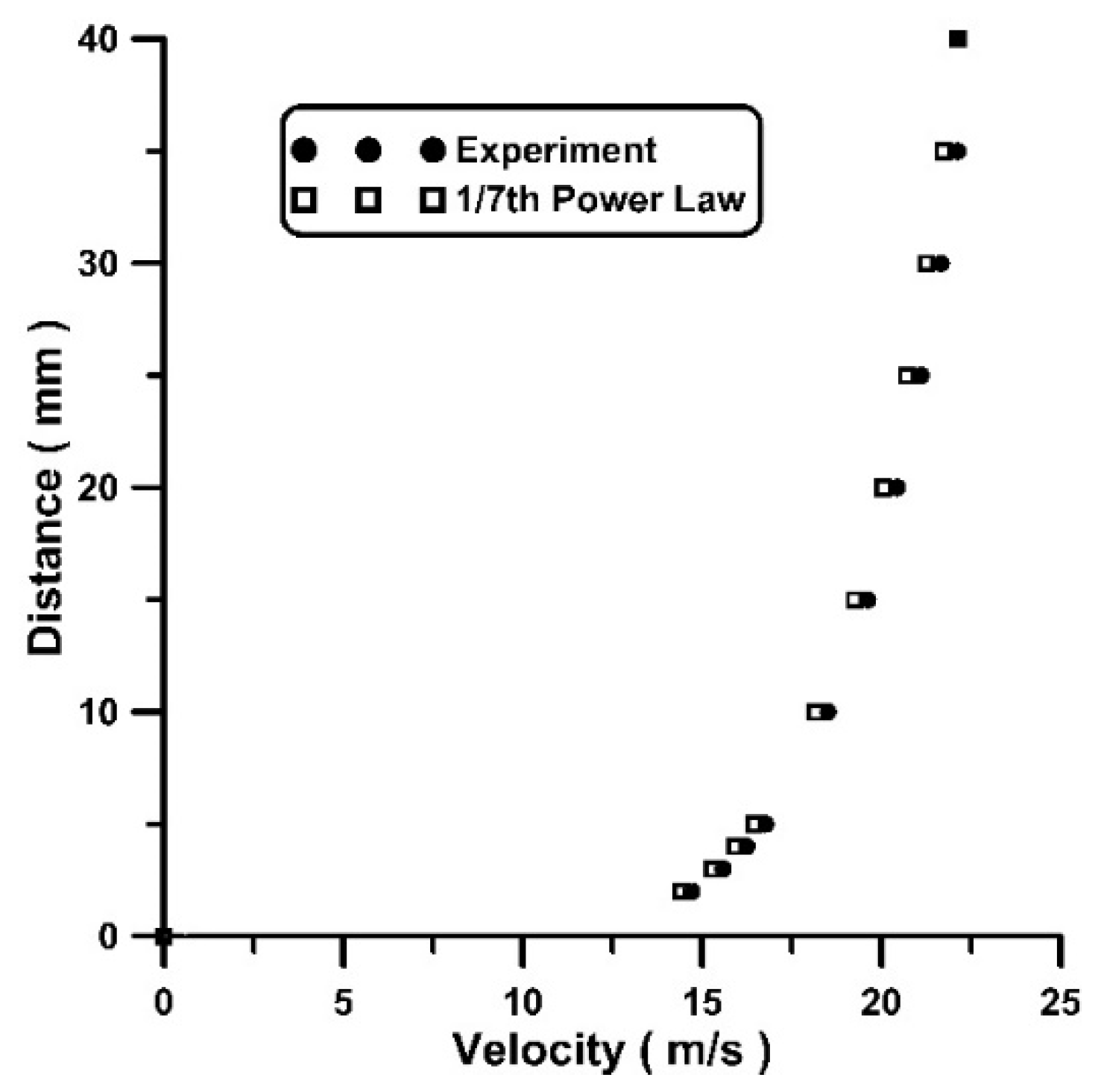

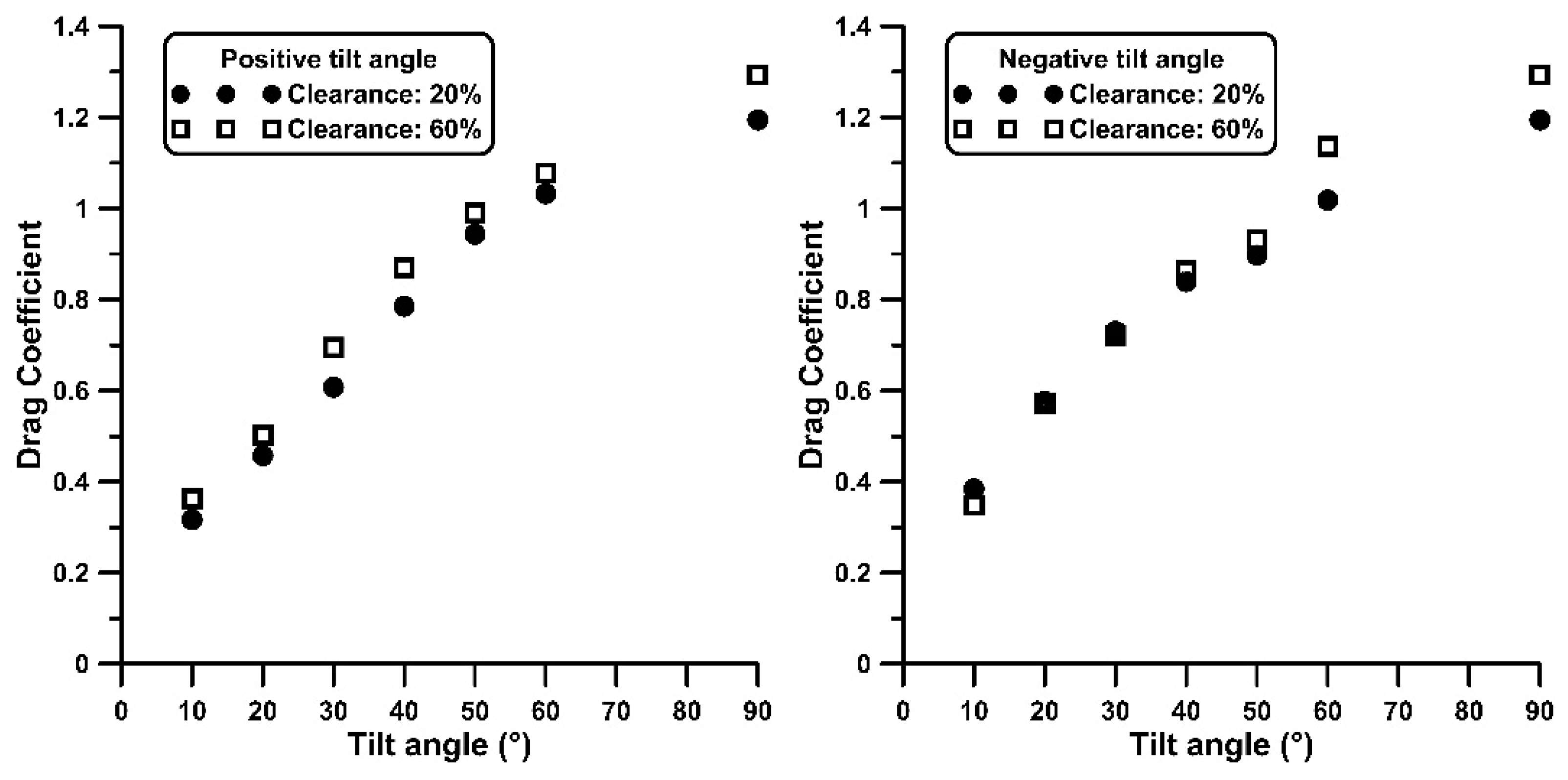
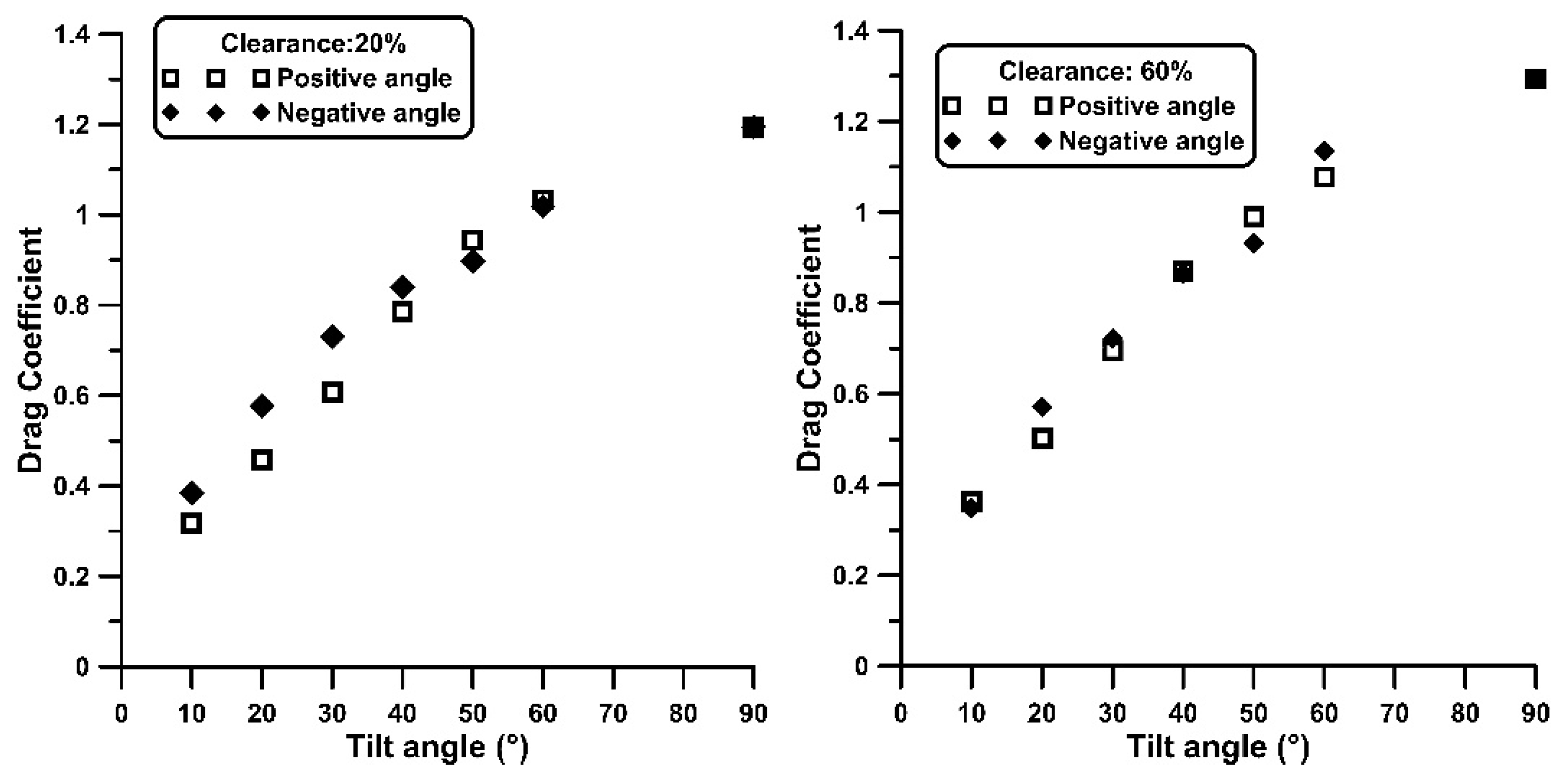
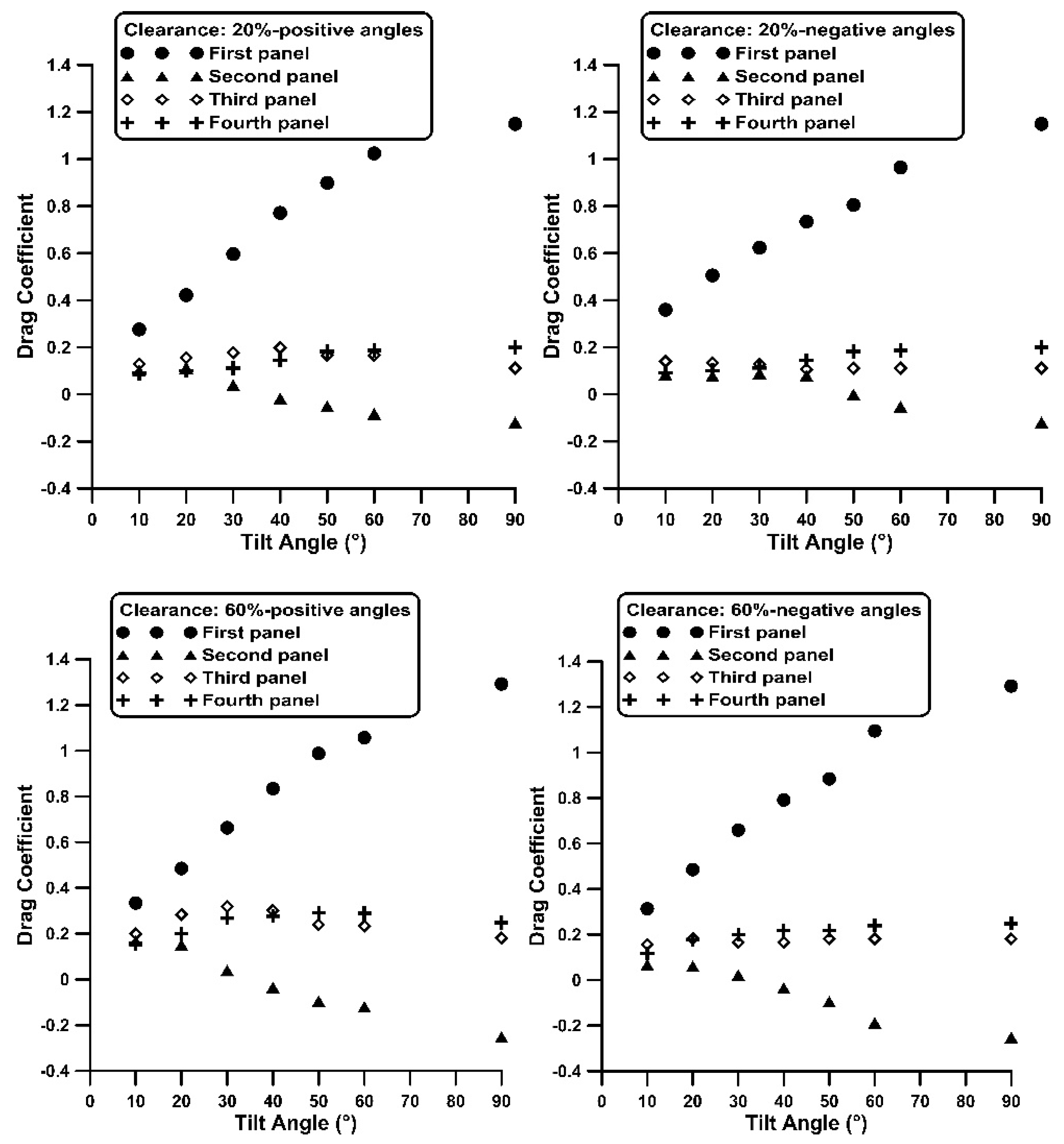
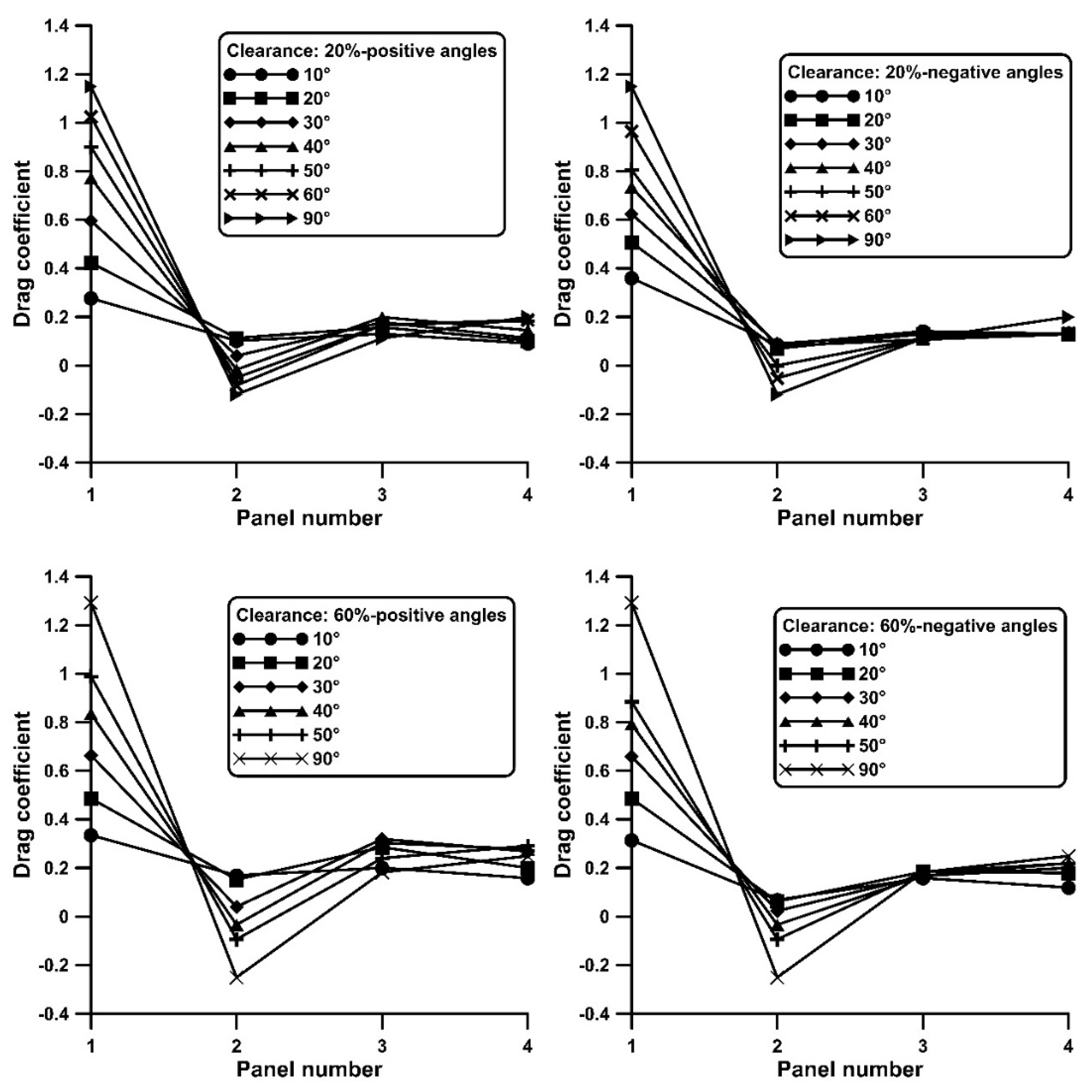
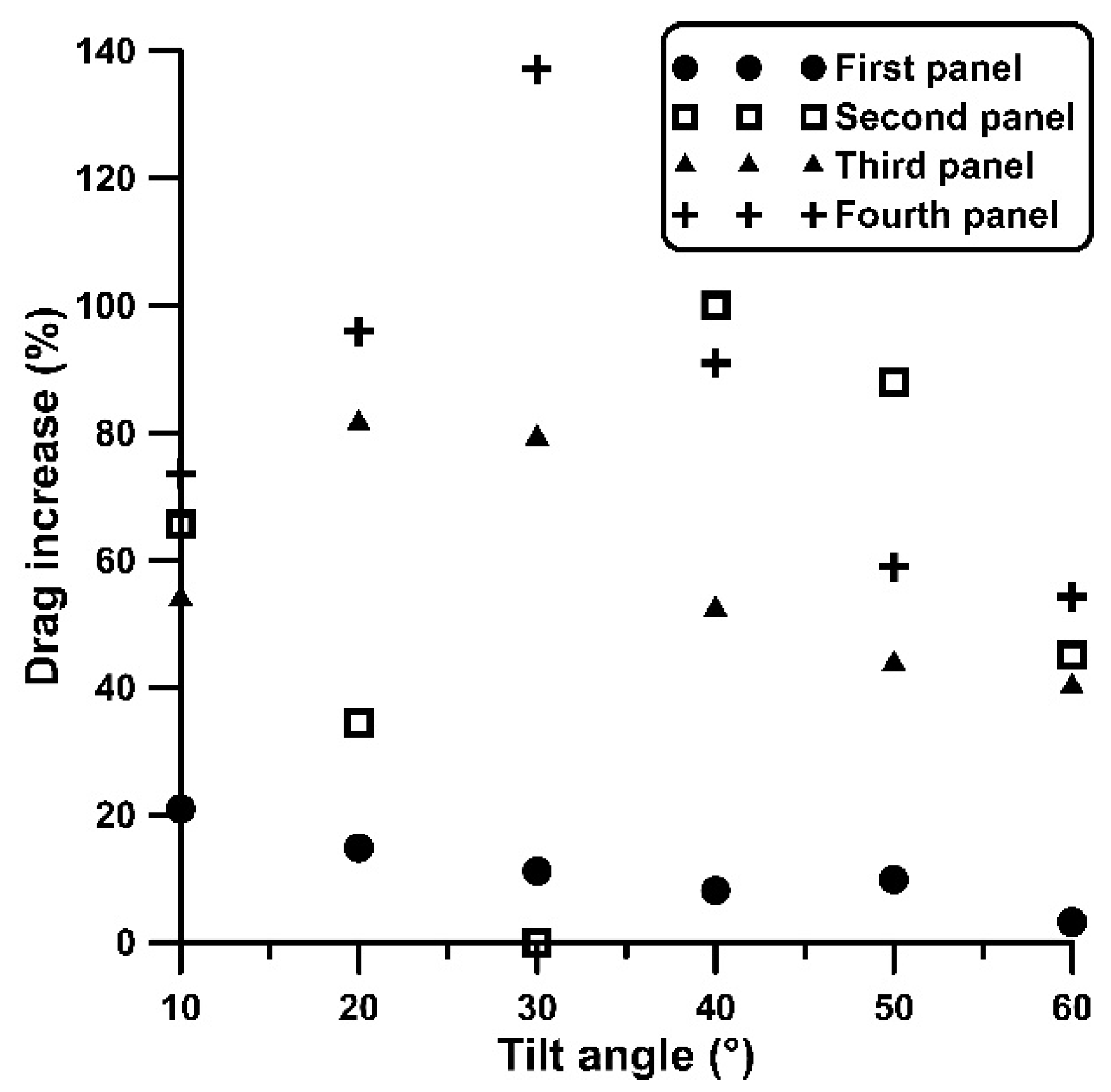
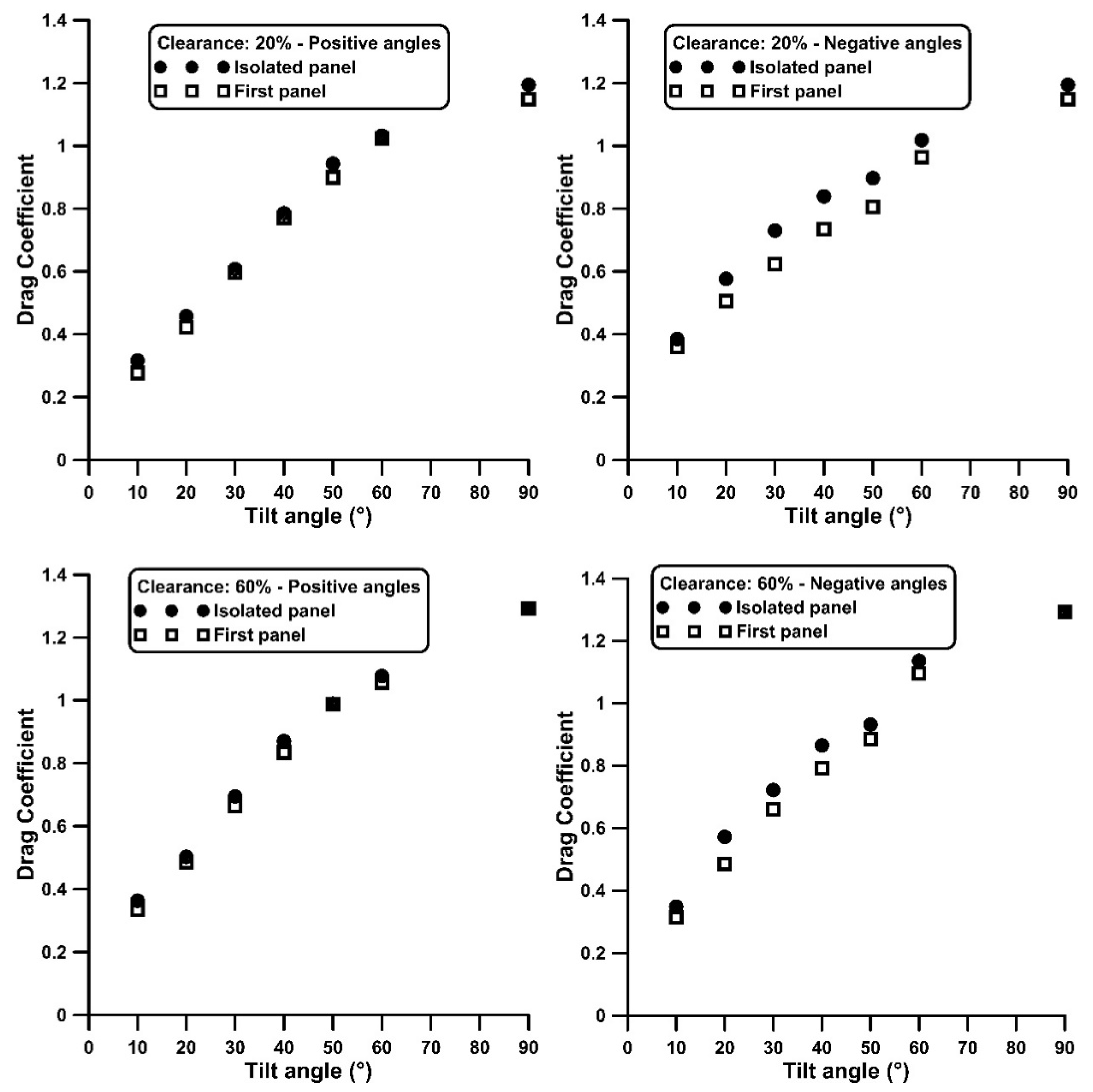
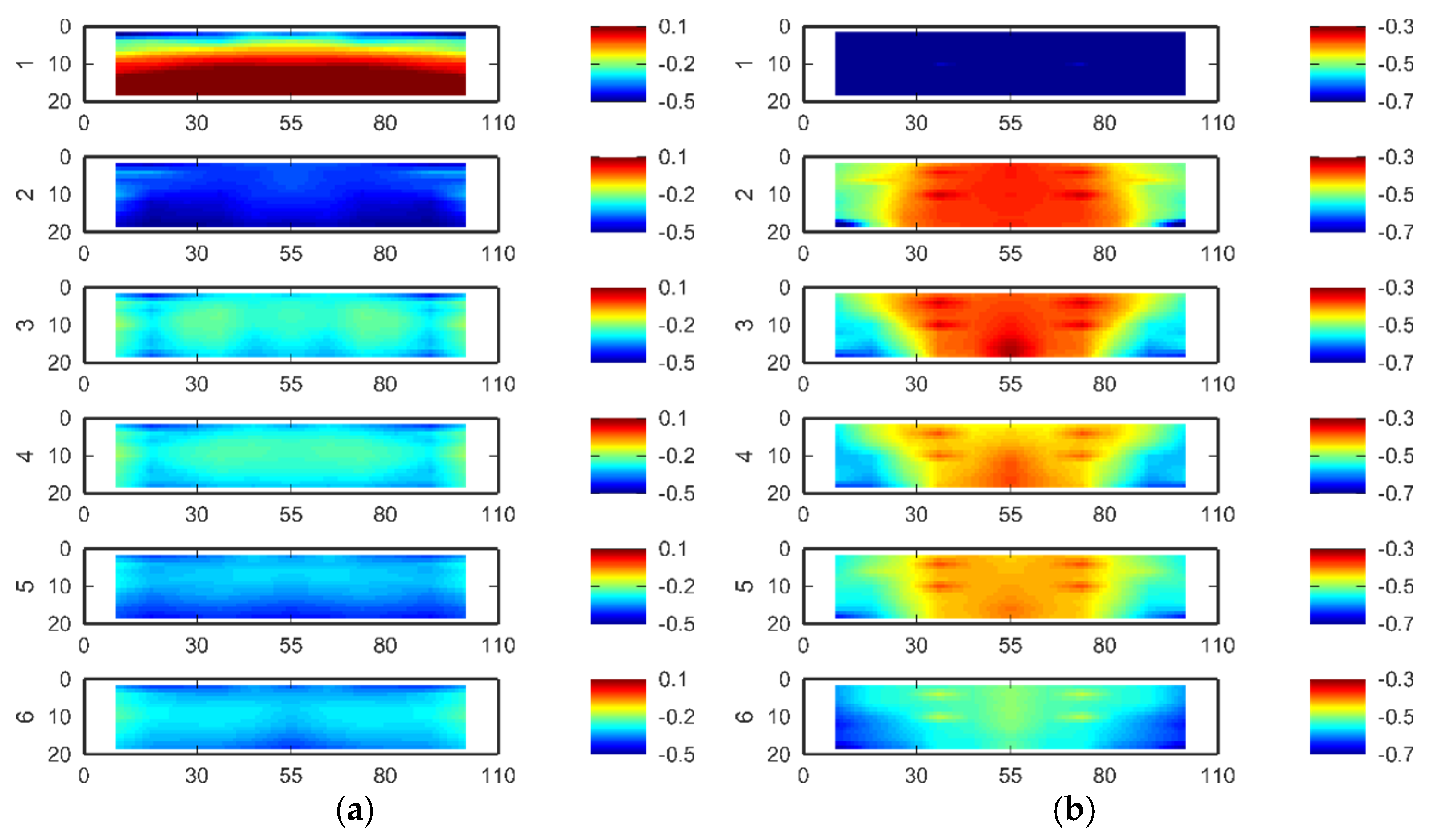



Disclaimer/Publisher’s Note: The statements, opinions and data contained in all publications are solely those of the individual author(s) and contributor(s) and not of MDPI and/or the editor(s). MDPI and/or the editor(s) disclaim responsibility for any injury to people or property resulting from any ideas, methods, instructions or products referred to in the content. |
© 2025 by the authors. Licensee MDPI, Basel, Switzerland. This article is an open access article distributed under the terms and conditions of the Creative Commons Attribution (CC BY) license (https://creativecommons.org/licenses/by/4.0/).
Share and Cite
Mathioulakis, D.; Vasilikos, N.; Kapiris, P.; Georgantopoulou, C. Ground Clearance Effects on the Aerodynamic Loading of Tilted Flat Plates in Tandem. Fluids 2025, 10, 155. https://doi.org/10.3390/fluids10060155
Mathioulakis D, Vasilikos N, Kapiris P, Georgantopoulou C. Ground Clearance Effects on the Aerodynamic Loading of Tilted Flat Plates in Tandem. Fluids. 2025; 10(6):155. https://doi.org/10.3390/fluids10060155
Chicago/Turabian StyleMathioulakis, Dimitrios, Nikolaos Vasilikos, Panagiotis Kapiris, and Christina Georgantopoulou. 2025. "Ground Clearance Effects on the Aerodynamic Loading of Tilted Flat Plates in Tandem" Fluids 10, no. 6: 155. https://doi.org/10.3390/fluids10060155
APA StyleMathioulakis, D., Vasilikos, N., Kapiris, P., & Georgantopoulou, C. (2025). Ground Clearance Effects on the Aerodynamic Loading of Tilted Flat Plates in Tandem. Fluids, 10(6), 155. https://doi.org/10.3390/fluids10060155



